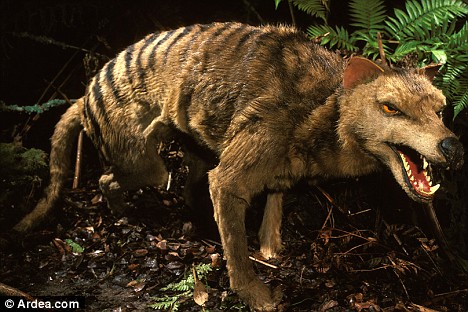The beasts we could raise from the dead: Return of the mammoth 'only a matter of time'
By Fiona Macrae
Last updated at 11:10 PM on 07th January 2009They don't sound like a terribly appealing bunch - a dodo, a sabre-toothed tiger, a woolly mammoth and a lumbering armadillo the size of a car.
But they are top of a list of animals that scientists would like to bring back from extinction.
Other beasts on the resurrection wish-list include one of our ancient relatives, Neanderthal man, as well as the woolly rhinoceros and the Tasmanian tiger - a fierce marsupial that looked rather like a large, striped dog.

Ripe for resurrection: The New Scientist claims bringing back the woolly mammoth is now a possibility, with a modern-day elephant being a suitable surrogate mother
Experts say it may only be a matter of time before all these animals could be brought back from the dead. After all, 50 years ago the notion of cloned animals such as Dolly the sheep would have seemed impossible.
The top ten most desirable creatures to bring back from the dead was compiled by New Scientist magazine.
It is limited to animals that have become extinct in the past 100,000 years - ruling out dinosaurs but raising the chances of intact DNA being available for analysis.
The revival formula also requires a living and closely related species to act as a surrogate mother, donating an egg and her womb.

Wish list: The Irish elk, which had antlers up to 13 feet wide, is in the top ten list of species to be revived
But the top ten is not completely rooted in science - it also takes into account each creature's 'megafaunal charisma' - or thrill factor.
Heading the pack is the woolly mammoth, with a genetic code that was unlocked last year and the modern elephant standing in as a surrogate mother.
The sabre-toothed-tiger, which has been extinct for 10,000 years, scores highly on both feasibility and charisma. Well-preserved DNA is available and the lion has been earmarked as a good egg donor and surrogate mother.

A stuffed specimen of the Tasmanian tiger
With the Tasmanian tiger, the sourcing of DNA is already taken care of. The creature has only been extinct for some 70 years and several museums around the world hold specimens preserved in alcohol.
The brevity of a marsupial pregnancy would cut the risk of the interloper being rejected and after birth, the youngster could be raised on milk in an artificial pouch.
The woolly rhinoceros is also a good bet, with plenty of specimens preserved in permafrost and suitable surrogates available.

But the revival of the glyptodon, a colossal armadillo which rumbled across South America until 11,000 years ago, relies on some DNA being unearthed. The pregnancy could also prove problematic, because today's small armadillos would struggle to carry the foetus to term.
The odds of the dodo's return are not good either. Despite being extinct for only 300 years, DNA is in short supply. The top ten is completed by the moa, a 10ft tall bird, the Irish elk, which sported antlers 13ft wide, the short-faced bear and the giant ground sloth.
New Scientist says: 'Of course, bringing extinct creatures back to life raises a whole host of practical problems, such as where they will live, but let's not spoil the fun.'
Other animals on scientists' Resurrection ListWhat is it: Glyptodon
When did it become extinct: An armadillo the size of a VW Beetle, the Glyptodon defended itself with a spiky, club-like tail. It disappeared 11,000 years ago.
How could they 'resurrect': There are no frozen Glyptodons, which lived in South America, so recovering DNA would only be possible from well preserved remains in cool, dry conditions such as a cave.
What is it: Irish elk
When did it become extinct: Once found across Europe, the Irish elk had antlers more than 13ft wide and stood two metres tall at the shoulder. It became extinct 7,700 years ago.
How could they 'resurrect': The closest living relative is the much smaller fallow deer, but the two species went their evolutionary ways around 10 million years ago.
What is it: Short-faced bear
When did it become extinct: Despite its name the short-faced bear, which became extinct 11,000 years ago, dwarfed the polar bear - the world's current largest living land carnivore.
How could they 'resurrect': There are specimens encased in permafrost from which DNA could be recovered. The species' closest living relative is the spectacled bear of South America.
What is it: Woolly rhinoceros
When did it become extinct: The woolly rhinoceros became extinct 10,000 years ago.
How could they 'resurrect': Many specimens are preserved in permafrost and hair, horns and hooves could provide DNA. Ironically all modern rhino species are on the brink of extinction.
What is it: Giant ground sloth
When did it become extinct: The giant ground sloth stood nearly six metres tall and is believed to have weighed four tonnes. It disappeared 8,000 years ago.
How could they 'resurrect': Several specimens have been found with hair, but finding a suitable surrogate mother would be a challenge as its nearest living relative - the three-toed tree sloth - is tiny by comparison.
What is it: Moa
When did it become extinct: A distant relative of the ostrich from New Zealand, the Moa disappeared only 508 years ago.
How could they 'resurrect': It might be possible to 'boot up' the Moa genome in an ostrich egg, but no bird of any description has yet been cloned.
Source: http://www.dailymail.co.uk/sciencetech/article-1108642/The-beasts-raise-dead-Return-mammoth-matter-time.html
